Established in 1983
Beginning in 1983 with only 27 cyclists, Chequamegon has now grown to become one of the more revered off-road MTB festivals in the country. Below is a history of the race and the stories made in the Northwoods of Wisconsin.
How about a bike race on the Birke Trail?
In a unique attempt to hatch a post-season tourist draw to the area Telemark employees Tom Kelly, Dan Hunt, Mike Cooper and Phil VanValkenberg and Phil Rasmussen of the Lakewoods Resort brainstormed the idea of a bicycle race on the American Birkebeiner ski trail.
The Chequamegon MTB Festival was born as a featured point-to-point 40 mile off road event from Main Street Hayward, WI to Lakewoods Resort in Cable. Contrary to popular belief, Gary Crandall, aka “The Fatman” and soon to be long time event director, did not dream up the event concept, however he did race in it the first year and finished a very respectable 12th. Admittedly there were only 27 riders but not bad for his first off-road race.
If ever there was a case of the right people, in the right place, at the right time, coming up with the right idea, this was it. Mountain bikes were coming into popularity, the American Birkebeiner trail offered a challenging race course, accommodations and volunteers were plentiful, and it doesn’t get any more beautiful than Northern Wisconsin in mid-September. The originators thought it couldn’t miss and 25 years later it is clear that they were right
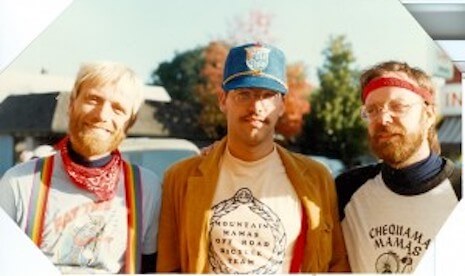
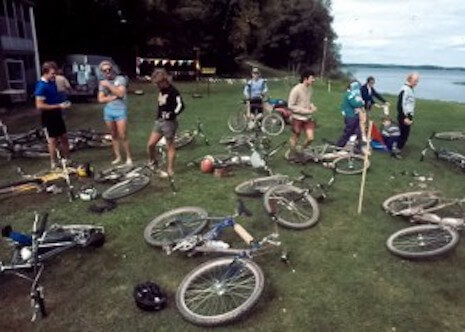
Event Host Difficulties Overcome
Fueled by a brisk late winter wind from the north across Lake Namakagon, the main lodge of the Lakewoods Resort burned to the ground in March.
Demonstrating the ever-tenacious attitude of the northland residents and business people, the folks at Lakewoods made plans for rebuilding the hotel from the ground up and never missed a beat in hosting the 1985 event. Often referred to as the “Year of the Tent,” that year the food, beverage and awards functions were held in a big top canvas tent hoisted on the shores of Lake Namakagon. It wouldn’t be the last big top canvas to be hoisted on the Chequamegon finish line.
Off-Road Pros Head to Chequamegonland
The pinnacle of the off road professional ranks discovered Wisconsin when the Chequamegon was sanctioned as the first Midwest Off Road Championship by NORBA in 1985. Joe Murray, Jammin’ Jim Deaton and George Theobald from the fledgling Fisher Bicycle pro team arrived in Cable for their first Midwestern appearance.
Murray, one of mountain bike racing’s early icons was the man to beat on the NORBA sanctioned off road pro circuit. A spring 1985 Fat Tracks article invited the top regional riders to “Beat Joe Murray” and contained a friendly challenge to give the national guys a run for their money.
In his first attempt at Chequamegon 40 fame, Murray, the reigning National Off Road Champion was beaten to the finish line by defending champion Mark Frise of LaCrosse, WI. In a return visit Murray took third in 1987. His appearance helped spread the word that the Chequamegon was a quality event worthy of national level riders.
While not a nationally sanctioned big cash purse event, the unique mass start point-to-point nature and quality reputation of the Chequamegon 40 has attracted a number of off road and on road professionals over the years. To name just a few of the cycling racing and historical luminaries who have attended: Mountain Bike Hall of Fame Inductees Joe Breeze, Ned Overend, Steve Tilford and David Wiens, Klein’s Rishi Grewal, US Postal Service Tour de France veteran Marty Jemison, Trek VW rider Susan Haywood and National Champions Travis Brown and Jeremy Horgan Kobelski, Tour de France participant and commentator Bob Roll, Subaru/Fisher riders Heather Irmiger and Australian National Champion Mary Grigson, bicycle speed record holder John Howard and in the early years Raleigh pro Margaret Day and the “Ross Indians” team members Casey Cunselman and Joe Sloup.
Of course, we would be remiss if we failed to mention that three time Tour de France champion Greg LeMond cut his first off road teeth at the Chequamegon, but that is another great Chequamegon story.
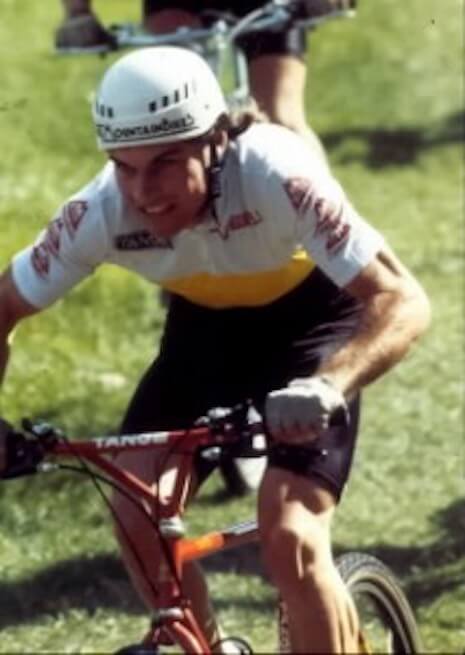
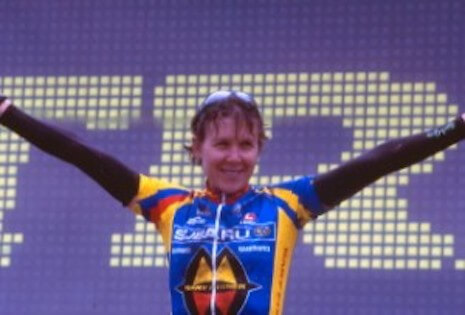
Last Place and Loving Every Minute of It
As a Northwood’s Renaissance man, Bob Pendleton of Hayward, WI lists local rancher, log roller, square dancer, Florida Everglades guide and Chequamegon 40 rider on his colorful resume. Pendleton’s name appears three times on one of the Chequamegon trophies, the Stone Saddle Award. Over the span of 1984 to 1986, while riding a 50 pound Murray, Pendleton completed a three-year streak of finishing dead last in the Chequamegon 40.
While he was fit and most capable in his completion of the long race, Pendleton was so sociable along the route that a lot of his time on the trail was spent chatting with riders, volunteers and spectators. He always finished but just took a long time to do so.
Because of Pendleton’s lengthy trail time (8 hours 15 minutes in 1985 and 6 hours 57 minutes in 1984), in the interest of volunteer retention, the Chequamegon organizers established the cut off time in the long race.
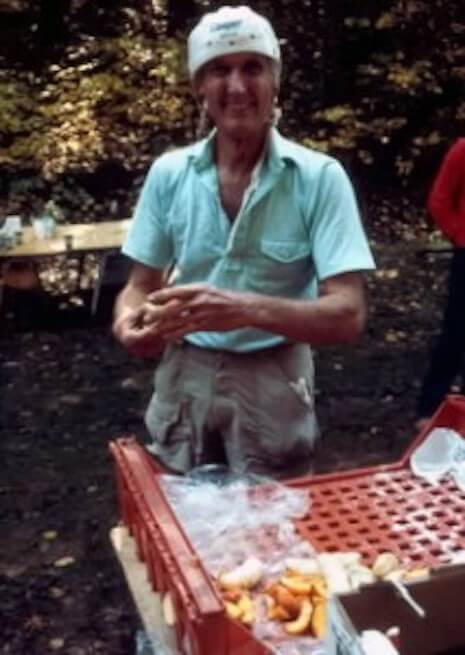
International Participation Welcome
Sensing that there was an untapped and growing market across the northern border of the United States, the Chequamegon organization has always encouraged international participation. As riders from Thunder Bay, Winnipeg and other Canadian destinations participated; discussion of creating a North American Championship ensued with the event organizers.
As an alternative concept, the first Canadian-American Team Challenge was created in 1987. The competition would accumulate overall times from mixed teams in the events three major competitions. The Can-Am Cup would be the prize for the winning international team. In spite of organizer’s hope that “it will be just like the Stanley Cup competition,” due to lack of participation, the Can-Am Cup had but a one year run.
Another international enticement that continues today is the award for the fastest Canadian in the Chequamegon 40. In 1984, Brian Forsythe from Thunder Bay, Ontario received the accolade and received the first place prize of a case of Molson’s beer. It has long been felt that the case of hearty lager left a more memorable impression on the northern visitors than the short lived Can-Am Cup.
Enough is Enough – Limits Set
There was good news and bad news with the continued growth of the Chequamegon participation numbers. The good news was that the event reputation was growing and that there seemed to be an unending number of people who wanted to ride in the cross-country events. The bad news was the same, the event reputation was growing and there were an unending number of people who wanted to ride.
The Chequamegon organizers were keenly aware that uncontrolled growth of an off road event in the fickle weather month of September could lead to potential problems. A limit of 2,250 riders was set in 1990 and later raised to 2,500 riders in 1991. The reasons for the limit were well thought out and have been the basis for the event’s adherence to the limit many years following.
Sustainability of the many trails used was one key factor in setting the limit. It made good responsible use sense to self-impose a limit to help preserve the forest resource for the future.
Insuring the safety of the riders was another key factor in setting the limit. A backwoods racecourse traversing 56 miles of remote routes presented some unique logistical challenges for emergency medical operations. Setting a limit on the event enabled the medical staff to provide the best point-to-point coverage on race day.
Quality of the event experience was yet another key event operational directive. Focus on a customer service ethic became the operational objective. With a limited enrollment, the event staff was tasked with making it better rather than making it bigger.
Finally, organizational sanity was another reason for capping the event size. Quite simply the event organization wanted to make the race weekend as fun for the staff and volunteers as the event participants and spectators. Limits enable us to focus on our well-defined assignment rather than react to last minute changes in the size of the field.
Others have argued that the limit should be dropped to let the event find its own upper limit of participation. The Chequamegon’s trail use ethic and operational objectives will continue to support the self-imposed limit of 2,500 until we are confident that a larger carrying capacity will not compromise the events sustainable philosophies. (Editors note: In 2011 the limit was raised to 2,750, the first increase in nearly 20 years.)
LeFat, LeMud, LeMond
This descriptive alliteration was the race weekend mantra of the early 1990s. Three-time Tour de France champion Greg LeMond attended and won his first mountain bike race in the rain shortened Chequamegon 40. He returned in 1991 to defend his title in yet another weather shortened 35-miler.
Not only did LeMond claim victory in the long race, in the days before the event in 1990 he caught a world-class line record bass in Lake Owen that was registered in Hayward’s National Fresh Water Fishing Hall of Fame.
LeMond’s attendance at the Chequamegon event was definitely one of the most memorable experiences for participants, volunteers, staff and spectators alike. His participation and championship brought a tremendous boost in media attention to the event.
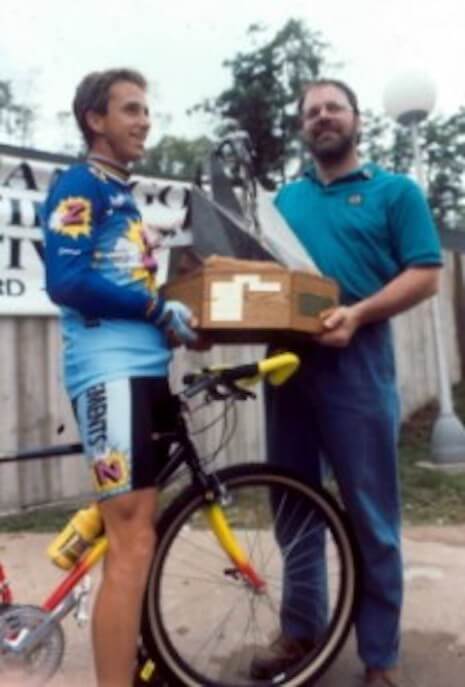
Klunker Toss Records Hold Over Time
The Sunday Funday events have always been a big part of the Fat Tire Fun in the Chequamegon race weekend equation. One of the popular activities, the Klunker Toss, gives the participant a chance to heave an old beater bike the furthest distance for bragging rights and some cathartic relief.
Perhaps it was a unique alignment of the planets, a stiff wind from the south or helium filled tubes on the Klunker Toss bike, but in 1991 the men’s and women’s records were set and have been unapproachable for over 15 years.
The men’s record was set and continues to be held by Steve Eberly, Bloomington, MN at 73’ 10”. Not to be outdone and setting the overall bench mark for the strength event, the women’s record was set in the same year by Beth Bertleson, Minneapolis, MN at 87’ 6”. The previous farthest toss for the men was 59’ and for the women 30′.
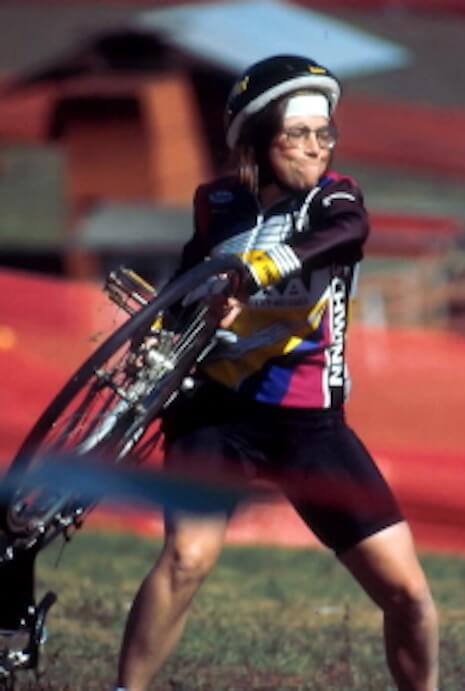
Advocacy Takes Root as CAMBA is Formed
The Chequamegon races had drawn a decade of attention to the area as a great place to bicycle ride in the woods. Each year more cyclists took advantage of the long season to ride the myriad of trails in the Sawyer and Bayfield County and Chequamegon National Forests. With the off road boom in full swing, it was clear that some user-friendly sense had to be made of the maze of off road possibilities.
In 1992, the Chequamegon MTB Festival joined a gathering of local business owners, cyclists, National Forest representatives and other dedicated trail advocates at the Cable Area Chamber of Commerce to brainstorm ideas for off road trail development. The Chequamegon Area Mountain Bike Association was created with the noble mission of promoting and developing the sport of bicycling by engaging in activities that encourage tourism and recreation in balance with the natural environment.
As an active participant in the CAMBA mission, the Chequamegon Festival contributed the initial seed money to kick off the fund raising and trail development efforts. In an exhaustive first year effort, routes were planned, maps were created, advertisements and sponsorships were sold, marketing efforts were launched and membership programs were developed. CAMBA was off and running with a goal of opening the system in 1993. Fifteen years later, the CAMBA legacy is well respected in the off road cycling community both regionally and across the country.
CAMBA has been a key focus of the Chequamegon’s advocacy commitment over the years. Each year since its inception the event has been a Gold Level Sponsor of the CAMBA programs. Chequamegon event schwag and entries have augmented numerous CAMBA events and fund raising efforts. The fund raising CAMBA Tour has long been a welcome part of the Chequamegon weekend.
Another good example of the event’s support of trail advocacy efforts is the Save the Trails fund that was initiated in 1996. By virtue of a volunteer contribution added to entry fees, Chequamegon entrants were given the opportunity to send along a donation for trail development. CAMBA and IMBA have been the beneficiary’s of those contributions with over $40,000 been contributed since the program began.
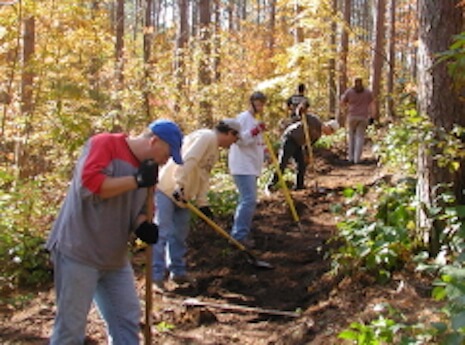
Trek Teams Up with Chequamegon
Each year’s special event puzzle is made up of many pieces contributing to the whole. Entrants, volunteers, race staff members, municipal bodies, business community, media and support staff, to name a few, make up the big picture of an event weekend. Sponsors are another essential component of that special events puzzle. For the Chequamegon no sponsor has played a bigger role than industry leader Trek Bicycle of Waterloo, Wisconsin.
Signing on as the Major Sponsor in 1993, Trek continues their long time association with the Chequamegon marking 15 years in 2007. Not only have they provided cash for event expenses, bicycles and accessories for merchandise prizes and event related supplies and participants premiums, they have been a constant source for encouragement, friendship and great times. In fact, since their association with the Chequamegon, a number of their long-time employees have built their vacation homes in the area. I’d say they are in for the long haul and for that, we say thanks.
At many other levels others have played a long time supporting role as sponsors. A review of the early 1980’s Fat Tracks will reveal sponsor logos from those who have been a part of the Chequamegon for over 20 years including: Bay City Bikes and Bodin’s on the Lake in Ashland, Bicycle Doctor, Rainbow Jersey and Wheel & Sprocket from the Milwaukee area, Chippewa Spring Water, Freewheel Bicycle in St. Paul and Yellow Jersey in Madison. Another sponsor soon to close in on 20 years of support is Event Host Telemark Resort that has been our home base since 1988.
What ever the length or level of association, congratulations is due to all our sponsors now and in the past for their part in our successful 25-year history.
For a complete listing of this year’s sponsors consult this issue of Fat Tracks. Don’t forget to thank them for their support with your patronage.
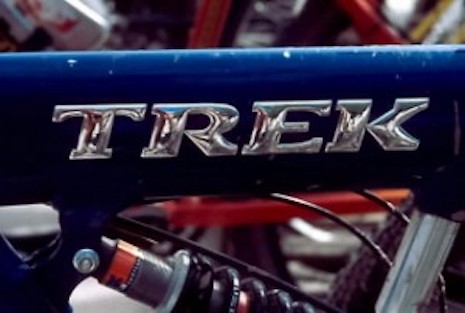
Bandits Removed from Finish Line
With limits being set and hundreds being turned away, a growing concern of the race promoters was the ever increasing number of unregistered riders at the start, on the course and coming across the finish line.
The size restrictions had put a finite number on the race field participants. For their own selfish reasons, a number of people decided they would ride unregistered. Not only were these bandits a legal liability of the event, they also countered the well thought out reasons for establishing the limit in the first place – sustainability of trails, safety of riders, quality of experience and organizational sanity. More importantly just about every bandit that crossed the finish line created a timing problem. Bandits greatly impacted the event’s ability to provide accurate timing for every registered rider.
Enter the Bandit Patrol in 1995. In the first year of their existence, the volunteer crew removed 80 plus people from the racecourse prior to crossing the finish line virtually eliminating the timing problems. There continues to be bandits in the event, however the presence of the Bandit Patrol has greatly moderated the problem helping to provide a better, safer and more sustainable event for all.
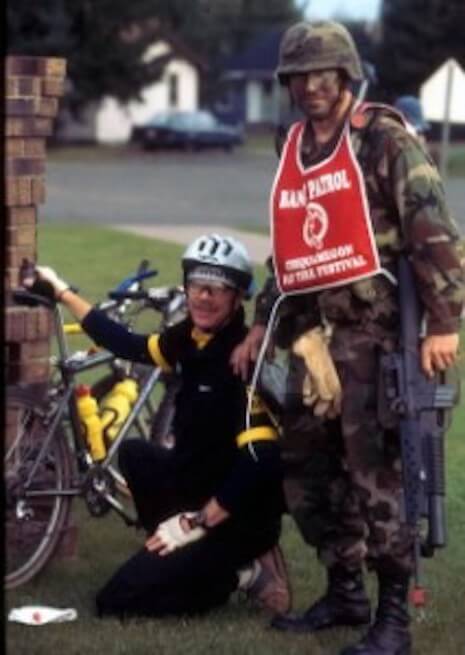
The Nation’s Most Popular Off Road Adventure
In 1983, the first year of the Chequamegon MTB Festival, 27 riders came across the Lakewood’s finish line. In subsequent years, it was clear that the event was destined for some serious growth. The participant numbers tripled in 1984, then doubled again in 1985. The numbers continued to increase by leaps and bounds paralleling the rapid growth of the relatively news sport’s popularity.
As the event neared the 1000 participant mark in 1989, in a friendly competition, our entry totals were matched with the entry totals of the big mountain and western state events. In particular, the heavily promoted and media blasted off road events at Mammoth Mountain in California always claimed to have the largest number of participants. We knew that the Chequamegon’s numbers were as big if not bigger than any of the large nationally sanctioned race circuit promotions receiving the media coverage. For some years in the late 1980’s and 1990’s we claimed the descriptive tag line of the “Nation’s Largest Off Road Adventure.”
When the Chequamegon entry limit was set at 2,250 in 1990 and later maxed out at 2,500 in 1991, the bragging rights for the “largest” event in the country was self-limited away from the Chequamegon Festival.
With the established limit, the event filled sooner and sooner each year. The event filled in August, then July, then in 1996 the 2,500 spots were closed out in March six month’s prior to the event.
Entry blanks for the next year were always made available at the current year but only a hundred or so would be taken over the event weekend for the next year. Quite unannounced or anticipated that dynamic changed drastically in 1997. That year, as people were getting ready to race the next day, the Chequamegon’s popularity went completely over the top.
Over the 1997 event weekend, in less than 24 hours, 2,500 spots for the 1998 Chequamegon MTB Festival sold out completely. At Friday’s bib pick up a large conga line formed to hand in the next year’s completed entry and payments. Several crews were quickly formed to try to keep the size of the line down to a manageable number but the word had spread, sign up now or miss out on next year. Many who didn’t want to wait in line and planned on signing up after Saturday’s races were greatly disappointed to find the 1998 event completely sold out before noon on Saturday.
After that unprecedented, historic experience, the event confidently labeled and retained the title of the Chequamegon MTB Festival as the “Nation’s Most Popular Off Road Adventure.”
Event Site To Be Determined
Seeking a venue that could handle the larger numbers of participants, the Chequamegon event moved from Lakewoods to Telemark Resort in 1988. As a special event site the larger resort offered the growing event ample parking, spacious grounds, race office space, spectacular trails and room to expand. The move to Telemark was welcome but it was not without some difficult moments.
A challenging event planning scenario developed in the fall of 1998, when Telemark Resort had closed its doors due during the timeshare developer’s bankruptcy. When entry blanks were sent out in early 1999 the location of the event was publicized as “Telemark Resort or some other suitable location.” Event organizers weren’t exactly sure where the event was going to be held that next September but were confident that they could work out the logistics of Plan B should it become necessary.
As luck would have it, that next spring, the members of the Telemark Interval Owners Association voted to purchase the Telemark Resort and reopened it to the public in April of 1999. The resort welcomed the event back with open arms as it began the long process of rebuilding it business. Over the next two years the event worked diligently to help clean up the finish line venue, which was the site of the partially dismantled Telemark Colosseum. We tip toed around the broken glass and big iron I-beams from the building demolition and made the best of it.
With our adaptation we learned that the first rule of event planning is make sure that you have a Plan B and it wouldn’t hurt to have Plan C and D ready too if things don’t go as originally scripted.
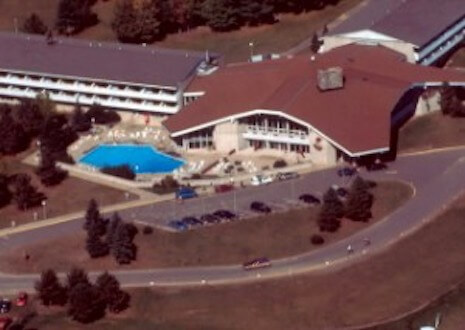
Are you Feeling Lucky; Well Are You
As noted in the 1997 highlight, the Chequamegon event’s popularity was completely out of control. With the filling of the 1998 event one full year in advance, it was quite impossible for anyone who didn’t attend one year’s event to get in the next year’s event. Before entry blanks could be made available and distributed the event had the 100% chance of being completely filled each year for the next year. Something had to change in the registration dynamic to not penalize the future hopefuls who wished to be a part of the “Nation’s Most Popular Off Road Adventure.”
Against strong long time participant opposition, a registration random lottery was established for selecting 2,500 participants in the 1999 Chequamegon 40 & Short & Fat. The limit was set at 1,700 for the 40-miler and 800 for the 16-miler. There was a short window of opportunity to obtain and submit completed entry blanks and payment by the March 15 lottery date.
The Chequamegon’s registration lottery would become March Madness for the mountain bike community. With a lottery drawing shortly after the March 15 entry submission postmark deadline, hopeful participants are anxious to learn if they are among the chosen 2,500. With the time involved to input data and sending confirmation cards, lottery participants learned to check their local banks to see if their checks had been cashed, a sure sign of acceptance into the event. Those whose checks were not cashed were destined to receive the “better luck next time letter.”
While the cumulative number of participants who have registered and raced over the event’s 25 year history is quite remarkable, the large number of entry returns since the limits were set and lottery established is equally impressive. Since 1995, 7,500 entries have been returned to sender sent back once the Chequamegon events were filled.
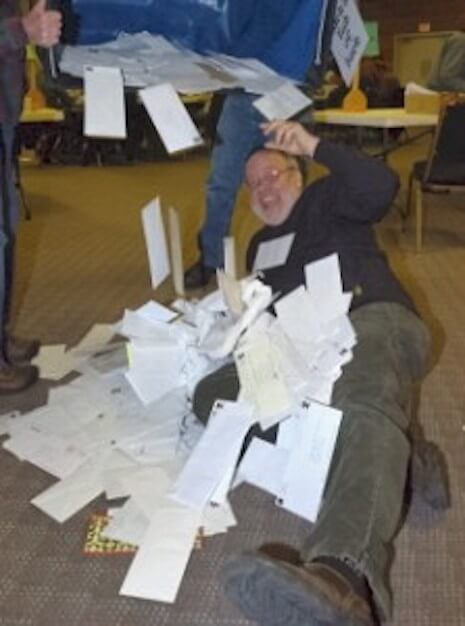
Just How Can We Get in this Event?
With a lottery selected limit of 2,500 riders and between 400 and nearly 1000 un-chosen entries returned each year, many disappointed people look for any possible way to get in the sold out Chequamegon cross country events.
“Please let just one more rider in” come the relentless email, phone call, written and personal pleas. In an effort to preserve event director Gary Crandall’s sanity in dealing with the countless discretionary requests a contest was created to give the lottery losers reason for hope of being included.
With an apologetic nod to the original lyrics and music of Paul Simon’s “50 Ways to Leave Your Lover” the “50 Ways to Ride the Chequamegon” essay contest was created in 1999.
Just let us know why, Sly.
You might get lucky, Chucky.
If you are picked by the crew, Sue.
To the ’99 Chequamegon you will go, Joe.
Using an undisclosed 15 point scoring system, contest submission are reviewed and scored. From the nearly 250 submissions, 50 winners are sent reserved registrations for the current year’s event.
Every imaginable motivation from health, family, history, competition, camaraderie and the like is listed for wanting a chance to enter the event. Contest submissions take the form of written letters and stories, original and parodied song lyrics, children’s drawings, videotapes and humorous bribes.
One past winner had $500 in Monopoly money attached to his letter with the note “There is plenty more where that came from.”
There are no losers in this contest, as all submissions are sincere and well stated, however there are only fifty winners who get a reserved registration to get in the event.
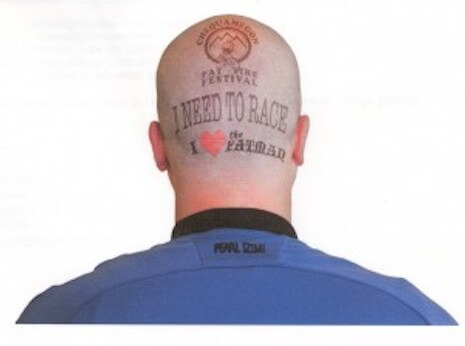
Guatemalans Meet the Chequama Mamas
An autographed Guatemala National Team jersey hangs on the Chequamegon office wall, courtesy of two Central American racers who traveled far from home to visit northern Wisconsin in 1999 and 2000.
An email introduction started the ball rolling for the journey of Andres Duarte and Alejandro Siguere from Guatemala City to Cable, Wisconsin. The over and under 23 year old champions of Guatemala, Duarte and Siguere were searching for a late season race closer to their home than the 1999 World Championships in Are, Sweden. A Guatemala City to Los Angles to Denver to Minneapolis to Cable connection isn’t exactly a short commute to a special event but the adventurous duo found their way to the Chequamegon start lines.
In 1999, Duarte rode well with the leaders in the Chequamegon 40 up to the hills just after the Seeley Fire Tower climb. At that moment of athletic performance truth, the bonk set in and he dropped off the top riders pace.
The younger Siguere made a run at the Short & Fat championship. He set tempo and hung with the leaders throughout the 16 miles only to be dropped on the final climb to finish on the podium third. It was interesting to note that both the foreign visitors characterized the Chequamegon courses as quite flat compared to their mountainous homeland.
In 2000, the congenial Siguere returned to seek the Short & Fat championship one more time. He was victorious recording the then third fastest time on the short course of 52:18 narrowly edging out local favorite Scott Chapin of Hayward for the title.
Guatemalans Meet the Chequama Mamas
An autographed Guatemala National Team jersey hangs on the Chequamegon office wall, courtesy of two Central American racers who traveled far from home to visit northern Wisconsin in 1999 and 2000.
An email introduction started the ball rolling for the journey of Andres Duarte and Alejandro Siguere from Guatemala City to Cable, Wisconsin. The over and under 23 year old champions of Guatemala, Duarte and Siguere were searching for a late season race closer to their home than the 1999 World Championships in Are, Sweden. A Guatemala City to Los Angles to Denver to Minneapolis to Cable connection isn’t exactly a short commute to a special event but the adventurous duo found their way to the Chequamegon start lines.
In 1999, Duarte rode well with the leaders in the Chequamegon 40 up to the hills just after the Seeley Fire Tower climb. At that moment of athletic performance truth, the bonk set in and he dropped off the top riders pace.
The younger Siguere made a run at the Short & Fat championship. He set tempo and hung with the leaders throughout the 16 miles only to be dropped on the final climb to finish on the podium third. It was interesting to note that both the foreign visitors characterized the Chequamegon courses as quite flat compared to their mountainous homeland.
In 2000, the congenial Siguere returned to seek the Short & Fat championship one more time. He was victorious recording the then third fastest time on the short course of 52:18 narrowly edging out local favorite Scott Chapin of Hayward for the title.
Mountain Bike Hall of Fame Recognizes The Fatman
Located in one of the historical off road cycling breeding grounds, the Mountain Bike Hall of Fame in Crested Butte, Colorado is recognized as the sports historical record keeper. As a part of those historical archives, each year since 1988, the MBHOF has invited its members to nominate, elect and induct new members into the hall. Candidates come from a variety of industry categories including advocacy, industry, journalism, pioneers, promotion and racing history.
The MBHofF inductees are a mountain biking Who’s Who including: Joe Breeze, Gary Fisher, Ned Overend, Keizo Shimano, Tim Blumenthal, Julian Furtado, Travis Brown, Joe Murray, Steve Tilford, Tinker Juarez and John Tomac to name just a few.
With the industry encouragement by regional event supporters like Quality Bicycle Product’s Gary Sjoquist and Trek’s Harry Spehar and John Riley, the long history and grass roots significance of the Chequamegon MTB Festival was recognized by the MBHOF in 2003. In October of that year, at the bicycle Industry’s Interbike Show in Las Vegas, Chequamegon Festival director Gary Crandall took his place along side of other off road cycling figures as he was inducted into the Mountain Bike Hall of Fame.
For further details about the Mountain Bike Hall of Fame, including membership information details log on to www.mtnbikehalloffame.com or the next time you are in Crested Butte stop in and see the Chequamegon Fatman’s picture and bio in the Hall itself.
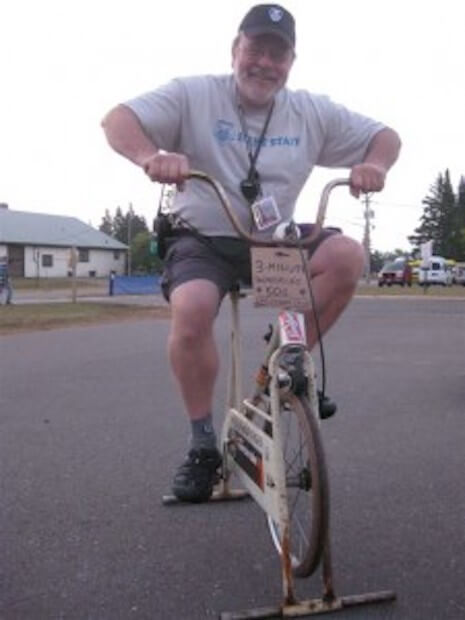
Chequamegon 40 Course Record Established
Over the 25-year-plus history of the Chequamegon 40 the route has changed just a bit each year. From the first five years when the long race ended at Lakewood’s Resort to the succeeding years when the finish line was at Telemark Resort, the quickest path to victory has been redefined a number of times.
Over these many changes it is difficult to compare one years time with another. Race day weather and trail tread conditions as well as routing selections impact how fast the winners go from Point A to Point B. Most notable of the impacts on the winning time were the rain shortened Chequamegon 40 races in 1990 and 1991 when the length was trimmed to 35 miles.
With that understanding and acknowledging that the Chequamegon 40 race route has not been significantly changed in the past half dozen years the record pace for the long event was set in 2003 by two-time champion, Trek/VW’s Doug Swanson of Bloomington, MN at 2:07:11.
US Postal Service team member and Tour de France veteran Marty Jemison of Park City, Utah had set the previous course record of 2:10:33 in 1998. Just last year, in 2006 Subaru/Gary Fisher rider and National Champion Jeremy Horgan Kobelski of Boulder, CO nearly broke the record with a 2:07:25 performance.
The women’s record has been set and reestablished a number of times also. Trek/VW rider Megan Monroe, Sheboygan, WI at 2:25:20, established current Chequamegon 40 women’s record in 2005. Other fastest time results for the women include the 2002 performance of 2:26:51 by Subaru/Gary Fisher Australian National Champion Mary Grigson of Golden, CO and Trek/VW regional rider Sara Kylander-Johnson, Duluth, MN finish of 2:25:59 in 2006.
Editors Note: The current Chequamegon 40 women’s record is held by Lea Davison, Jericho, Vermont in a time of 2;19:26.
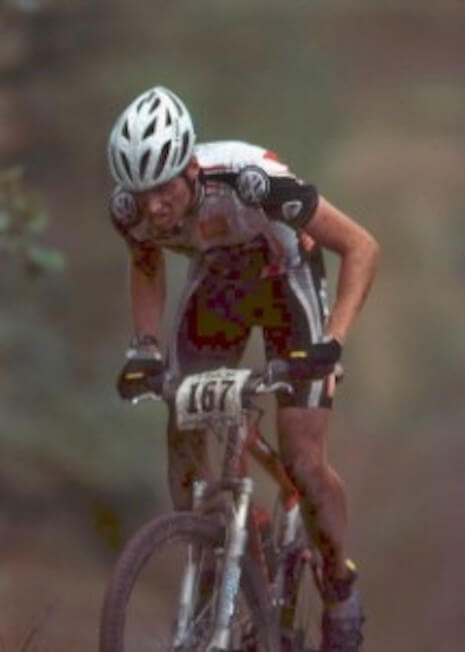
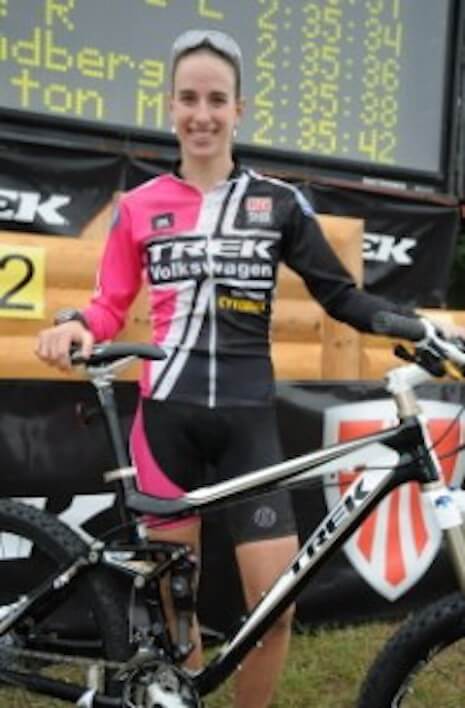
Artistic Expressions Reflect Chequamegon History
The history of the Chequamegon events has been recorded and relived in a variety of ways. Event results chronicle the competition from the victors to the very last place. Race photos provide a visual portrait of individual and group experiences. Stories from each person’s experience provide an oral history that is retold year after year.
The artistic creations by Drummond, WI artist Sara Balbin have also been a major component of the Chequamegon story. Balbin’s initial expressions of the event came in the form of the event logo, which with slight alterations over time has become the iconic representation of all things Chequamegon.
Early year participants will recall the wonderful 16” x 20” titled, numbered, signed and matted black and white prints that were given as participation awards. When the event numbers rose astronomically and writer’s cramps set in signing the many prints, that recognition was replaced by the limited edition lapel pins that have been created each year since.
Balbin’s unsurpassed-in-design set of permanent event trophies is a notable artistic contribution to the event. The five permanent trophies record Chequamegon championship history in a unique fashion. In recent years, the cross-country event champs have also received a smaller Balbin designed metal trophy.
Volunteer and concession apparel, some of the past poster designs, stickers, promotional flyers and many other creative expressions by Sara Balbin have added a special touch to the Chequamegon events for 25 years.
Editor’s note: Even if Sara Balbin wasn’t event director Gary Crandall’s lovely spouse and mother of their two wonderful children she would have been singled out for special recognition because of the huge creative contribution she has made to the Chequamegon’s colorful history. For further information about the Art of Sara Balbin visit www.sarabalbin.com
.
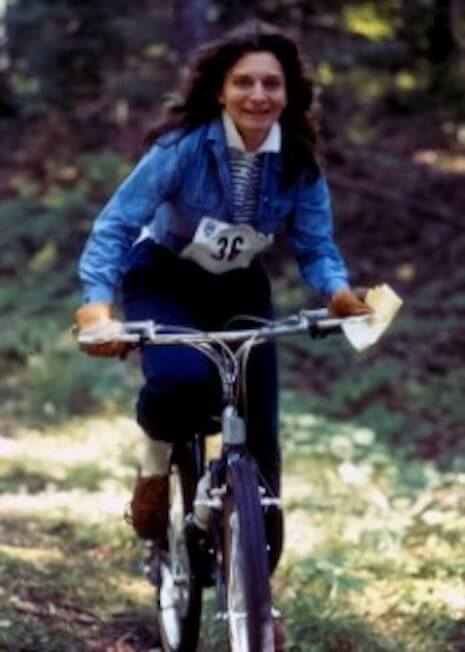
Founders Celebrate Their 25th
A 25-year year streak of successfully completing anything is a notable accomplishment. Of the 27 finishers at the first Chequamegon 40, three riders will complete their 25th, logging 1000 miles of off road adventure when they cross the Telemark Resort finish line in 2007.
Jeff Austin and Mike Gerke of DePere, WI and Dennis Kruse of Cable, WI belongs to the small fraternity of Fat Tire Founders. Interesting enough Kruse, at 39 years old was awarded the Old Man of the Woods plaque as oldest participant in the 1983 Chequamegon 40 a far distance from the current 80 plus year old who holds that title currently.
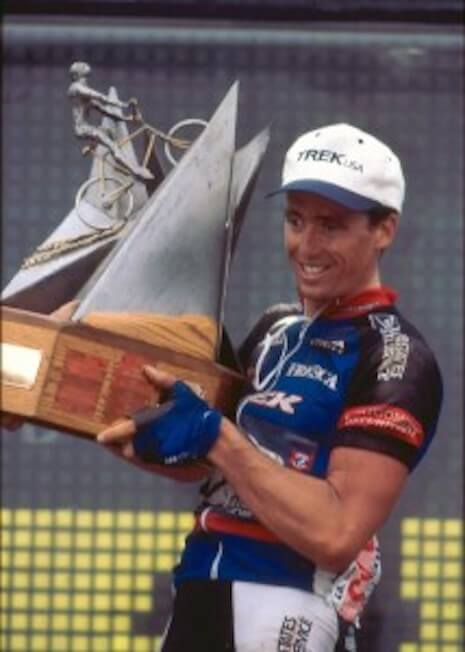
Gerke, who exudes the challenging and fun spirit of the Chequamegon philosophy, has not only raced in each event since the beginning, he has raced and completed the Chequamegon 40, Rough Stuff Rendezvous and Cable Criterium in each year of his participation.
Many may not recognize his name but many know the trails side repairs offered by Austin over his 25 years. Jeff has been responsible for getting more people across the finish line via the aid of his mechanical assistance than anyone in the history of the event.
Congratulations Jeff, Mike & Dennis, Chequamegon MTB Founders, friends and all around great guys.
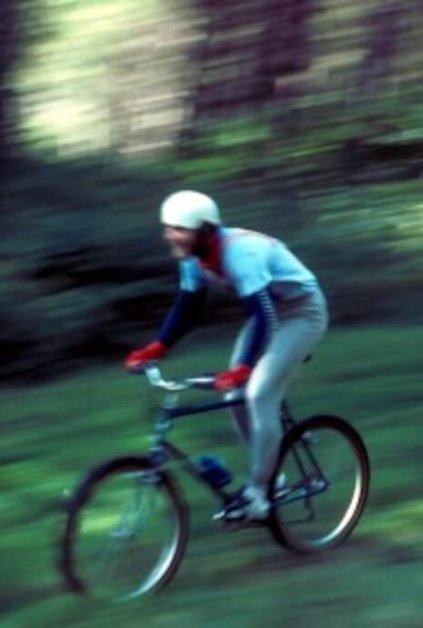
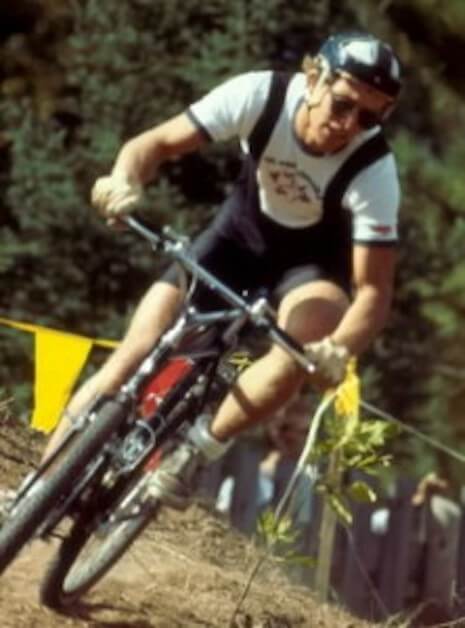
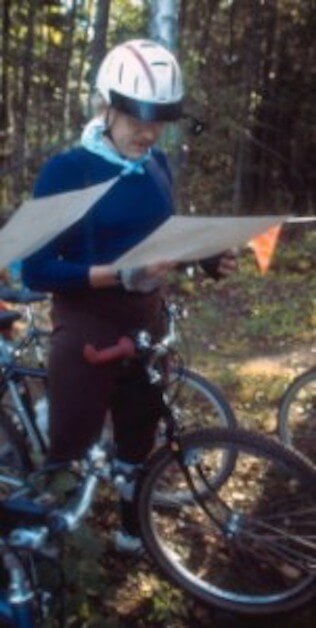
To cap off the 25th anniversary of the Chequamegon MTB Festival, Jesse LaLonde stunned the finish line crowd with his championship in the Chequamegon 40 riding a Fisher 29 inch singlespeed. LaLonde topped a keen men’s race field that included World and National champions, a multi-time Chequamegon 40 champion and the Chequamegon 40 course record holder. Great excitement for the silver anniversary of the Chequamegon event.
Notable Victories at the Chequamegon 40
Jonathan Page, noted USA cyclocross National Champion and World Championship podium finisher surged in the final two miles to capture the Chequamegon 40 men’s victory while Olympian Lea Davison, in her second appearance at the event, set a new course record for the women in her 40 mile championship bid.
Facelifts for Traditional Sunday Events
Over perhaps the most spectacular fall weekend in the event’s history, Brian Matter edged Cole House to win the men’s Chequamegon 40 in a record-breaking time of 2:02 while Jenna Rinehart claimed victory just barely missing the course record. Restructured from their traditional format, both traditional Sunday events were given a facelift. The bicycle orienteering Rough Stuff Poker Ride provided an un-timed competition category for individuals, groups and guided tours while the Cable Crit-Cross featured cyclocross obstacles on a short track closed circuit.
New Venue at Chequamegon MTB Festival
As in previous years the event was hosted on the property of Telemark Lodge, however this time the big hotel at Telemark was shuttered having closed earlier in the spring. All traditional inside functions were staged under the 80 x 160 foot “Big Top Chequamegon” tent. The event went off without a hitch with this new venue. Repeating as champions in the Chequamegon 40 were Brian Matter and Jenna Rinehart.
Partnership with Life Time Fitness Extends Participation
In mid-summer, Chanhassen, Minn.-based Life Time Fitness acquired ownership of the Chequamegon MTB Festival. The participation limit was raised to 2,750 riders to include 1,850 in the Chequamegon 40 and 900 in the Short & Fat 16 mile cross country events.
Chequamegon Celebrates 30th Anniversary
Rounding out three decades of fat tire racing and fun in northwestern Wisconsin the Chequamegon Festival celebrated its 13th anniversary. A tried and true format guided by an experienced race staff and supported by community volunteers has resulted in one of the great off road cycling success stories. Jenna Rinehart, Mankato, Minn. claimed her record making fourth Chequamegon 40 championship.
The Chequamegon Fun Continues On…
The registration limit for the Chequamegon Festival is raised to 3,100 made up of 2,100 Chequamegon 40 and 1,000 Short & Fat 16 lottery selected participants. A new online registration made its debut. Brian Matter lands in the record books as he takes his unprecedented fifth Chequamegon 40 championship. Once again event Host Telemark Resort had closed its doors but the event went off without missing a beat.
Stay tuned – more tall tales of Chequamegon to come.
